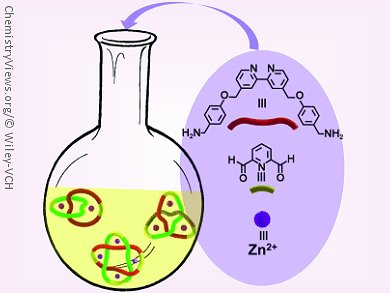Catenanes, trefoil knots, and Solomon links are topologies that are interesting for chemists not only from an aesthetic point of view, but also for their potential use in nanoscale devices. Designing systems that already produce two of these architectures is difficult, but Loïc Charbonnière, Ali Trabolsi, and their co-workers in France, Spain, the United Arab Emirates, and the United States have shown that all three species form in one pot under the right conditions.
They designed a pair of ligands, namely diformylpyridine and diamino-2,2′-bipyridine, that self-assemble in the presence of templating zinc(II) ions. The reversible formation of both the metal−ligand and imine bonds means that a dynamic combinatorial library is formed that automatically corrects structural errors and results in the formation of the thermodynamically most stable product. Mixing the reactants together in solution led to the formation of the trefoil knot as a precipitate. The remaining solution was evaporated to produce crystals of the [2]catenane.
High-resolution mass spectrometry was used to monitor the course of the reaction; all three species were observed in the first few minutes of the reaction, although the Solomon knot, which could only be detected by mass spectrometry, was found to be only transient and disassembled quickly to form smaller, more stable structures.
This work shows that the metal template/dynamic combinatorial system is a promising route for the formation of advanced topological architectures.
- Simultaneous Self-Assembly of a [2]Catenane, a Trefoil Knot, and a Solomon Link from a Simple Pair of Ligands,
Thirumurugan Prakasam, Matteo Lusi, Mourad Elhabiri, Carlos Platas-Iglesias, John-Carl Olsen, Zouhair Asfari, Sarah Cianférani-Sanglier, François Debaene, Loïc J. Charbonnière, Ali Trabolsi,
Angew. Chem. Int. Ed. 2013, 52, 9956–9960.
DOI: 10.1002/anie.201302425




